The stock vehicle was purchased from Paul Safari Components in Queenston, Ont. Paul is very knowledgeable about old Land Rovers and I have had to call on his expertise numerous times throughout the build. The vehicle was in good running condition at the time of the purchase, but it needed a bit of cosmetic tidying up. The first order of business was to test out the offroad capability prior to fabricating the living quarters. The Toronto Area Rover club has an annual spring outing (called April fools errand) in Grimsby, which offers great muddy roads to test your vehicle. In previous years, I never managed to drive the entire length of Always road with my series III land rover. I was quite surprised when it seemed like a non-event in the 101. This is partly due to the overall height of the vehicle, and the fact that the air intake is quite high. You can submerge the vehicle to about 1/3 the door before you run into trouble. That translates to about 50” of fording depth…pretty impressive for a stock vehicle. I’m sure you could get even more with some waterproofing and a snorkel kit, but I likely won’t be in a situation that would require that.
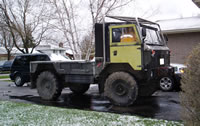
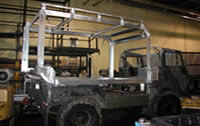
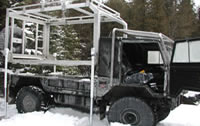
Having satisfied my offroading requirement, the disassembly began. The vehicle was stripped and I began to measure and design the living quarters. Once I had the final design, a Land Rover colleague Andrew Breithaupt provided me with a 3-D computer mock-up which helped considerably. I took the basic design to Ron Krueger of Krueger custom steel to get an estimate. The metal work went pretty straight forward, I described what I wanted, and they came up with something better! The skeleton was all aluminum, and the roll cage was all stainless steel….I hate rust. The only glitch arose when one of the guys discovered a puddle around the Rover before they were to weld that day. Apparently the fuel tank had sprung a leak and there was fuel everywhere. That likely would have made a big bang if they hadn’t noticed. Luckily, Paul had a fuel tank in stock, and had it to me by the next day. After many months (I’m sure Ron was glad to get the vehicle out of his shop), I had skeleton for the living area, all 4 winches mounted, and the external roll cage was complete.
From the welding shop, I drove directly to the local Apple Auto shop. Glen and Brian are very good at doing custom interior work and soft tops. I hadn’t considered their door height when I booked the vehicle in. I had forgot how much higher it was with the camper on it. Luckily with a broom to push up the door, it made it by an inch. They came up with a simple design for the soft top which can be removed in the summer. If you know anything about old Land Rovers, they are notorious for leaking in the rain. I must say, this is the first time I have driven a watertight Rover. With the sound-proofing, carpeting, and new seats, it is much more comfortable than I had dreamed. It is my vehicle of choice for running around town now.
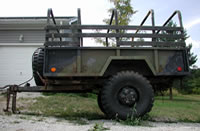
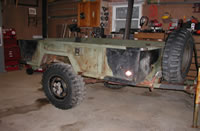
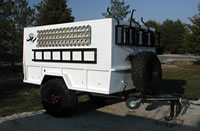
Now that the skeleton was complete, I was in the market for a boat builder to finish the exterior. I had been warned by Gary Wescott of the Turtle V project to stay with marine manufacturers rather than RV manufacturers as they are much more comfortable solving weight and space problems. I tried many companies in Canada, but none of them seemed too interested in a project this small. It didn’t seem small to me, but I guess compared to an eighty food yacht, its small. Having no success with a boat builder, I shifted my attention to the trailer. I had a local sandblaster clean the frame in my driveway, and I coated it with POR-15. I fabricated a steel exoskeleton with 2” angle iron. Unfortunately I forgot to measure the height of my garage door before I started. I guess to a welder, that’s the equivalent of me trying to take out a tooth without an x-ray of the roots…an exercise in frustration! After cutting the frame apart, I re-welded it outside in the middle of winter. Aluminum panels were bonded and riveted in place, all of the hardware was mounted and the vehicle and trailer were sprayed in panel white paint. Both the vehicle and trailer were sprayed inside with black bedliner